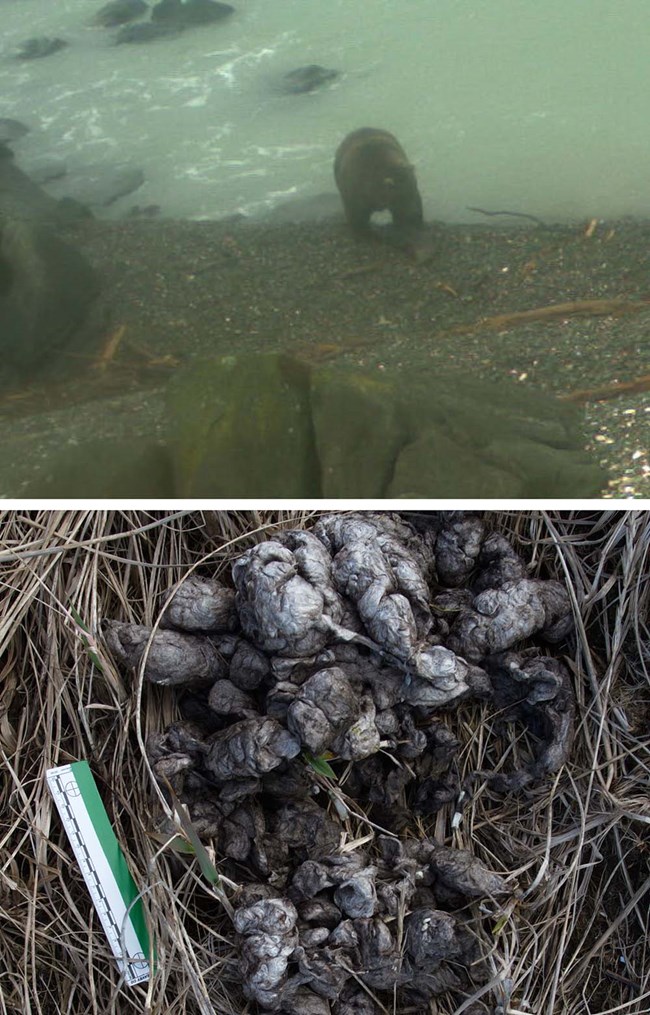Last updated: January 19, 2023
Article
Brown bear-sea otter interactions

Photos courtesy of U.S. Geological Survey/D. Monson
Katmai National Park and Preserve, renowned for its brown bears, is also home to a thriving sea otter population. Once hunted to near extinction across its range, the sea otter has recovered across large swaths of its former habitat, including coastal Katmai. These two top-level predators overlap in ways we did not necessarily expect. Brown bears are generalist predators that take advantage of a wide variety of prey items. Brown bears that live on the coast have even more options, as the ocean offers a bounty when the tide falls.
Not surprisingly, we’ve observed bears as competitors with sea otters in intertidal habitats where they dug clams, crushed barnacles, caught flounder, and chomped on sea stars and crabs. What we didn’t expect was that we would document brown bears hunting sea otters. Scavenging is a common mode of foraging for brown bears, but hunting hauled-out sea otters was a novel observation we documented on the Katmai coast using camera traps that were installed near haul-out locations for both sea otters and harbor seals.
But what led to us to thinking about bears hunting sea otters? As part of our long-term monitoring program, we collect sea otter carcasses to estimate the ages of the dying population. In a healthy population, we would expect the old and young to be the majority of the dying population. However, in Katmai, that was not the case. Many of the carcasses were prime-age animals, which prompted us to consider what might be happening. If prime-age animals were dying at a high rate in the population and being consumed as carrion, it would suggest the sea otter population was in trouble and likely declining. However, because we had population survey data and other supporting metrics, we found that predation was driving the larger proportion of prime-age adult carcasses left behind on beaches, and that the rate of hunting by bears, while significant to an individual otter, is not likely high enough to impact the sea otter population as a whole on the Katmai coast. Future studies should focus on the effects these top-level predators have on each other and how they may change over time.
Brown bear–sea otter interactions along the Katmai coast: terrestrial and nearshore communities linked by predation
Abstract
Sea otters were extirpated throughout much of their range by the maritime fur trade in the 18th and 19th centuries, including the coast of Katmai National Park and Preserve in southcentral Alaska. Brown bears are an important component of the Katmai ecosystem where they are the focus of a thriving ecotourism bear-viewing industry as they forage in sedge meadows and dig clams in the extensive tidal flats that exist there. Sea otters began reoccupying Katmai in the 1970s where their use of intertidal clam resources overlapped that of brown bears. By 2008, the Katmai sea otter population had grown to an estimated 7,000 animals and was likely near carrying capacity; however, in 2006–2015, the age-at-death distribution (AADD) of sea otter carcasses collected at Katmai included a higher-than-expected proportion of prime-age animals compared to most other sea otter populations in Alaska. The unusual AADD warranted scientific investigation, particularly because the Katmai population is part of the Threatened southwest sea otter stock. Brown bears in Katmai are known to prey on marine mammals and sea otters, but depredation rates are unknown; thus, we investigated carnivore predation, especially by brown bears, as a potential explanation for abnormally high prime-age otter mortality. We installed camera traps at two island-based marine mammal haulout sites within Katmai to gather direct evidence that brown bears prey on seals and sea otters. Over a period of two summers, we gathered photo evidence of brown bears making 22 attempts to prey on sea otters of which nine (41%) were successful and 12 attempts to prey on harbor seals of which one (8%) was successful. We also developed a population model based on the AADD to determine if the living population is declining, as suggested by the high proportion of prime-age animals in the AADD. We found that the population trend predicted by the modeled AADDs was contradictory to aerial population surveys that indicated the population was not in steep decline but was consistent with otter predation. Future work should focus on the direct and indirect effects these top-level predators have on each other and the coastal community that connects them.
Monson, D. H., R. L. Taylor, G. V. Hilderbrand, J. A. Erlenbach, H. A. Coletti, K. A. Kloecker, G. G. Esslinger, and J. L. Bodkin. 2022. Brown bear-sea otter interactions along the Katmai coast: Terrestrial and nearshore communities linked by predation. Journal of Mammalogy pp. 1-13.
